- Navajo Nation partners with DOE to plug orphaned wells.
- An archeology report highlights the impact on sacred sites in the Southwest.
- Federal rule changes could hold companies accountable for cleanup.
September 4, 2024 — The Navajo Nation has taken a significant step in safeguarding its lands and the health of its people by signing a Memorandum of Understanding (MOU) with the U.S. Department of Energy. This partnership, announced by Navajo Nation President Buu Nygren on August 28, 2024 , aims to address the ongoing issue of orphaned wells—abandoned uranium, oil, and gas wells that pose serious health and environmental risks.
, aims to address the ongoing issue of orphaned wells—abandoned uranium, oil, and gas wells that pose serious health and environmental risks.
“Plugging these wells is crucial for improving health outcomes for our 400,000 Diné people,” said President Nygren . The MOU outlines a collaborative effort to identify and manage these undocumented wells on Navajo lands. The DOE will provide technical assistance, resources, and training to help the Navajo Nation build its capabilities in this critical area. An implementation plan will be developed within 180 days to guide the work.
. The MOU outlines a collaborative effort to identify and manage these undocumented wells on Navajo lands. The DOE will provide technical assistance, resources, and training to help the Navajo Nation build its capabilities in this critical area. An implementation plan will be developed within 180 days to guide the work.
Archaeological Concerns in the Southwest.
A report released by Archaeology Southwest in February 2024 sheds light on the broader implications of orphaned wells across the Southwest, particularly their impact on sacred and cultural sites. The report focuses on sensitive areas like the Greater Chaco Landscape and Bears Ears National Monument, where the legacy of oil and gas development has turned sacred spaces into what Paul Reed, New Mexico Program Director at Archeology Southwest, calls “industrial sacrifice zones.”
sheds light on the broader implications of orphaned wells across the Southwest, particularly their impact on sacred and cultural sites. The report focuses on sensitive areas like the Greater Chaco Landscape and Bears Ears National Monument, where the legacy of oil and gas development has turned sacred spaces into what Paul Reed, New Mexico Program Director at Archeology Southwest, calls “industrial sacrifice zones.”
The report underscores the pressing need for stricter federal regulations to prevent further degradation of these important cultural landscapes. With thousands of orphaned wells near national parks and sacred sites, the urgency for robust federal policies is more pronounced than ever. Phil Francis, Chair of the Coalition to Protect America’s National Parks, emphasized the urgency, stating, “We cannot afford to allow the orphaned well crisis to grow even bigger.”
Future Protections and Accountability.
The Bipartisan Infrastructure Law of 2021 allocated $4.5 billion to plug abandoned wells on tribal, state, and federal lands. However, much more is needed to address the root causes of the orphaned well crisis. The Bureau of Land Management (BLM) is now proposing updates to federal bonding requirements that would ensure oil and gas companies are held responsible for the full cost of cleaning up their wells, potentially marking a significant shift in accountability.
This MOU between the Navajo Nation and the DOE, along with the ongoing efforts by organizations like Archaeology Southwest, represents a crucial step forward in protecting the land and the health of communities in the Southwest. President Nygren said, “This MOU is another step in the right direction to keeping our families safe here on the Navajo Nation.”
Access the Memorandum of Understanding Here .
.
Summary of the MOU Between the Navajo Nation and DOE.
The Memorandum of Understanding (MOU) between the Navajo Nation and the U.S. Department of Energy’s Office of Fossil Energy and Carbon Management (DOE-FECM) outlines a collaborative effort to address undocumented orphan wells on Navajo lands. This MOU establishes the intent of both parties to work together to enhance the Navajo Nation’s capacity for identifying and managing these wells while sharing resources, technical assistance, and data.
between the Navajo Nation and the U.S. Department of Energy’s Office of Fossil Energy and Carbon Management (DOE-FECM) outlines a collaborative effort to address undocumented orphan wells on Navajo lands. This MOU establishes the intent of both parties to work together to enhance the Navajo Nation’s capacity for identifying and managing these wells while sharing resources, technical assistance, and data.
Key Points:
- Collaboration Focus: The partnership aims to build the Navajo Nation’s capabilities in identifying undocumented orphan wells using historical records, drone surveys, and on-ground measurements.
- Data Sharing: All data collected and interpreted will be shared between the parties to maximize the benefit to the Navajo Nation.
- Support and Training: DOE-FECM will provide technical assistance, resources, and training to support the Navajo Nation’s orphan well identification and management programs.
- Implementation Plan: An implementation plan is to be developed within 180 days of signing the MOU to guide the collaborative efforts.
This agreement is effective for five years and can be renewed or terminated with notice. It does not create legal obligations or financial commitments but serves as a framework for cooperation.

